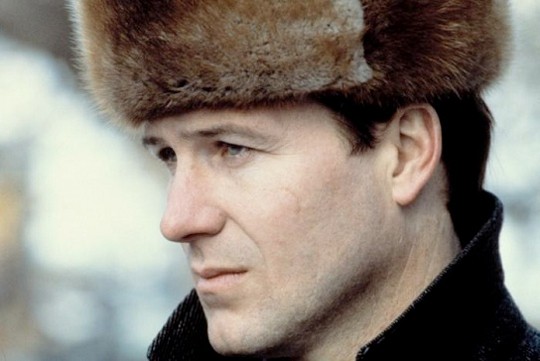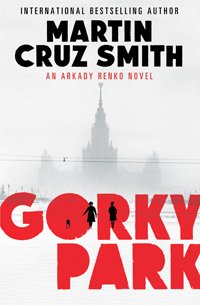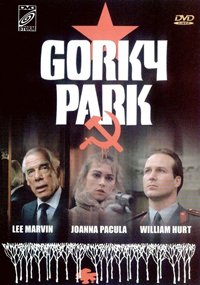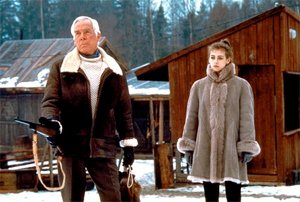
 Ronald Reagan was steering his course to the White House when Gorky Park came out in 1981. Meanwhile, an ageing autocrat called Leonid Brezhnev, with mighty eyebrows, was the General Secretary of the USSR. In the West, we worried about mutually assured nuclear armageddon. The Soviets seemed hard, emotionless enemies of freedom. Or, perhaps that’s just what we were told to think. Then along came Martin Cruz Smith with a wonderfully textured, vivid look behind the Iron Curtain. Gorky Park was a tense, atmospheric and memorable crime story with an outstanding detective character – Arkady Renko (played by William Hurt in the film, above). Let’s step back in time for another look.
Ronald Reagan was steering his course to the White House when Gorky Park came out in 1981. Meanwhile, an ageing autocrat called Leonid Brezhnev, with mighty eyebrows, was the General Secretary of the USSR. In the West, we worried about mutually assured nuclear armageddon. The Soviets seemed hard, emotionless enemies of freedom. Or, perhaps that’s just what we were told to think. Then along came Martin Cruz Smith with a wonderfully textured, vivid look behind the Iron Curtain. Gorky Park was a tense, atmospheric and memorable crime story with an outstanding detective character – Arkady Renko (played by William Hurt in the film, above). Let’s step back in time for another look.
It’s early spring in Moscow, and the book opens with the discovery of three bodies in Moscow’s famous Gorky Park – two men and a woman. They’ve been shot at close range, their fingertips pruned and faces sliced off with a rough-bladed knife. Identities can’t be verified. Strangely, they’re wearing ice skates but are among the trees some distance from the park’s rink. Not the normal alcohol-fueled crime Muscovites are used to – will it be a case for the KGB’s Major Pribluda, or will it fall to Chief Investigator Arkady Renko of the local militia (the police, in other words)?
Renko is a brilliant investigator. Dangerously so. He cares more about solving crimes than laminating his Communist Party membership card. This is a source of consternation to his wife, who begins an affair that humiliates him. The KGB has put a man in his team of detectives. Meanwhile, Iamskoy, the Moscow town prosecutor draws him close, offers protection and tries to demonstrate some of the benefits of playing the Party way. Renko is a guest at the prosecutor’s dacha, and in another sequence accompanies him to a secret bathhouse – one built for Joseph Stalin’s pleasure – where he eats caviar and drinks champagne with aging communists. There he meets a rich, powerful American fur dealer called Osbourne who seems to have the key to the city.
 Cold, hard Moscow
Cold, hard Moscow
We glimpse the other side of Moscow too, into the dingy cafeterias, clapped out cars, shabby apartments and empty shops, meeting lawyers and gypsies, teachers and black marketeers. They might be emancipated from any notion of bourgeois individualism, but life is a collective struggle. Renko questions Irina Asanova, owner of the ice skates worn by the female victim. One night, he spots someone acting suspiciously near the crime scene. He chases the man – an American – and is beaten up. Could it have been Osbourne?
Our hero proves his skills by identifying the bodies, with the help of Prof Andreev, a dwarf at the university who uses what was a revolutionary technique at the time. He reconstructs their faces with clay, adding the musculature to the skulls. Turns out, one of the victims was an American called James Kirwill, and his brother is a New York cop who happens to be in Moscow as a tourist. Is he investigating the deaths as well? Will William Kirwill prove an enemy or ally for Renko?
The plot grows even more dense, and the storytelling increasingly tense. As Renko tries to make connections between Osbourne, the KGB, Iamskoy, Kirwill and the murdered troika, someone attempts to kill Irina, and then him. The hunter becomes the hunted, everything closes in, but he never gives up. Perhaps it’s because he’s fallen in love with Irina Asanova.
How accurately the Soviet Union is portrayed is difficult to judge. But it seems totally believable and the paranoia is palpable. “I was completely convinced by the verisimilitude of the novel,” says crime author Adrian McKinty, who cites Martin Cruz Smith as an influence. “It was clear that Smith had done the research and it totally paid off. There was nothing cheesy or silly about this portrayal of Soviet detectives. It was detailed, nuanced, subtle and interesting – quite the breath of fresh air in the Cold War 80s.”
If the frigid claustrophobia of Moscow is what makes the first half of the book such wonderfully dark reading, it’s the second half where the author proves his brilliance. Renko’s enemies catch up with him and he’s critically wounded. He’s sent south to recover in a hospital where he’s the only patient. A prisoner and patient, he’s interrogated relentlessly, but won’t cave in. Major Pribluda is sent to guard him. And though the man once seemed his nemesis, Renko realises that even this KGB officer is human. There’s a symmetry between the two men – they define each other.
 Venus in furs
Venus in furs
The climax of Gorky Park takes us to New York. Irina’s link to the fur dealer Osbourne means that somehow she’s been allowed to leave the Soviet Union. Somehow, Osbourne has arranged via the FBI and KGB for Renko to visit the US. The KGB wants something returned which is valuable to Russia. The FBI? What do they want? Osbourne’s goal is to be even richer, and Renko and Irina want one another. Plus, the loose cannon detective William Kirwill is in the mix. Again, Arkady Renko must do all he can to keep his integrity intact, and to stay alive. And again we see a symmetry between the detective, and the killer he’s hunted to the other side of the world.
Renko didn’t return until the fall of the Soviet Union enabled Cruz Smith to reunite his detective with Irina in Polar Star, in 1989. He appeared in five further novels and will be in our reading pile again soon with the release of Tatiana on 12 November. Though shot in Finland and Sweden, the 1983 film Gorky Park captured the atmosphere of the book very well. William Hurt portrayed Renko excellently, under the direction of Michael Apted, with Dennis Potter’s screenplay. Lee Marvin appeared as Jack Osbourne and Brian Dennehy was a convincing William Kirwill. The cast also included Alexi Sayle (a smuggler), Michael Elphick (Renko’s subordinate Pasha), Ian Bannen (Iamovsky) and even Richard Griffiths (a lawyer).
It would be surprising if Renko and Martin Cruz Smith’s depiction of Moscow didn’t provide at least a little inspiration for writers like Ian Rankin and Henning Mankell, along with Adrian McKinty. “Atmosphere has always been a big part of my novels and I think the Renko books alongside Chandler’s LA showed me that the city is an important character in its own right. I also love the way Smith gets you inside the nightmarish police bureaucracy. I’ve used that too in my own procedurals,” says McKinty.











Great stuff. A fantastic book.
Martin Cruz Smith’s Masterpiece… the film was weak… deserves to be remade… William Hurt didn’t get the treatment he deserved… neither did the book… the film was pure euro-trash ! READ THE BOOK…
Am just reading Siberian Dilemma. Again involving rich men and grotty run down parts of old Soviet Russia. Quite a slim book with large print so nearing the end but good to see Arkady still involved with femme fatale and flawed characters. Not so happy about bears being killed but its an enjoyable read.